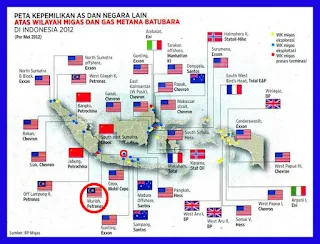Sharing provisions based on gross production or gross split on regulations issued by the Ministry of Energy and Mineral Resources in January 2017 were revised. It happens because there are many inputs to this concept.
Regulation of the Minister of Energy and Mineral Resources Number 8 of 2017 which contains the provision of gross split is revised in Minister of Energy and Mineral Resources Regulation No. 52/20171 Deputy Minister of Energy and Mineral Resources Arcandra Tahar said the revision of gross split is motivated by various inputs from the economic side.
"From the inputs, we immediately conduct an evaluation. For the new rules, we use models based on the data we have, "said Arcandra, Friday (9/8), in Jakarta.
The model used is a production-sharing contract (PSC) calibrated in 12 different oil and gas field characteristics. In this model, in the fifth year the effective proportion of gross split is projected to be greater than the cost of recovery. In the scheme of the previous regulation, the effective proportion of gross split is projected to be greater than the cost of recovery in the sixth year.
ESDM Ministry involves several parties in the preparation of revisions of gross split. "One of them is from Indonesian Petroleum Association (IPA) and World Bank ," said Arcandra.
Of all revisions, Article 7 changed significantly. In the previous regulation, the Minister of Energy and Mineral Resources may add a percentage share of 5 percent to the contractor of commercial field calculation not reaching a certain economy. Conversely, if the calculation of commercialization of the field exceeds a certain economy, the ESDM Minister may add 5 percent to the state of the contractor.
Economic aspects
In the latest regulation, this 5 percent figure is eliminated. Arcandra said the discretion would go both ways.
"In the future, we not only consider the economic aspects, but also the technical aspects of the field and challenges. Based on that consideration, we will consider the incentives, "he said.
In addition to the elimination of figures on ministerial discretion, the proportion of gross split for contractors was also added. The next field development (POD II) will get an additional 3 percent for the contractor. In the previous rule POD II did not get any extra.
For the production phase, there is a profit-sharing increase for the contractor. In the previous rule, secondary production earned a 3 percent revenue share. Under the new rules, revenue share for secondary production is 6 percent. The secondary production stage refers to the production of oil by artificial efforts in supplying pressure to the reservoir.
Profit sharing for contractors at the tertiary production stage also increases. Previously, the 5 percent revenue share. In the new regulations, the proportion reaches 10 percent. Arcandra hopes that the revision of gross split will encourage oil and gas investment in Indonesia. IPA Executive Director Marjolijn Wajong welcomed the government's good intentions to attract investors.
"We agree with this latest gross split figure. Next week, we will discuss related taxes with the Minister Finance, "Marjolijn said.
IN INDONESIA
Ada Masukan, Aturan Bagi Hasil Direvisi
Ketentuan bagi hasil berdasarkan produksi kotor atau gross split pada peraturan yang diterbitkan Kementerian Energi dan Sumber Daya Mineral pada Januari 2017 direvisi. Hal itu terjadi karena ada banyak masukan terhadap konsep ini.
Peraturan Menteri Energi dan Sumber Daya Mineral Nomor 8 Tahun 2017 yang memuat ketentuan gross split direvisi dalam Peraturan Menteri ESDM No 52/20171 Wakil Menteri ESDM Arcandra Tahar mengatakan, revisi terhadap gross split dilatarbelakangi oleh berbagai masukan dari sisi ekonomi.
”Dari masukan-masukan itu, kami langsung melakukan evaluasi. Untuk aturan baru, kami menggunakan model berdasarkan data yang kami miliki,” kata Arcandra, Jumat (8/9), di Jakarta.
Model yang digunakan yakni kontrak bagi produksi (PSC) dikalibrasi di 12 lapangan migas yang berbeda karakteristik. Dalam model ini, pada tahun kelima proporsi efektif gross split diproyeksikan lebih besar dibandingkan biaya pemulihan. Dalam skema pada peraturan sebelumnya, proporsi efektif gross split diproyeksikan lebih besar dari biaya pemulihan pada tahun ke enam.
Kementerian ESDM melibatkan beberapa pihak dalam penyusunan revisi gross split. ”Salah satunya dari Indonesian Petroleum Association (IPA) dan Bank Dunia,” kata Arcandra.
Dari seluruh revisi, Pasal 7 berubah secara signifikan. Pada peraturan sebelumnya, Menteri ESDM dapat menambahkan persentase bagi sebesar 5 persen pada kontraktor perhitungan komersialisasi lapangan tidak mencapai keekonomian tertentu. Sebaliknya, apabila perhitungan komersialisasi lapangan melebihi keekonomian tertentu, Menteri ESDM dapat menambahkan 5 persen untuk negara dari kontraktor.
Aspek keekonomian
Pada peraturan terbaru, angka 5 persen ini dihilangkan. Arcandra mengatakan, diskresi ini akan berjalan dua arah.
”Ke depan, kami tidak hanya mempertimbangkan aspek keekonomian, tetapi juga aspek lapangan dan tantangan secara teknis. Berdasarkan pertimbangan itu, kami akan mempertimbangkan besar insentifnya,” ujarnya.
Selain penghapusan angka pada diskresi menteri, jumlah proporsi gross split untuk kontraktor juga ditambahkan. Pengembangan lapangan selanjutnya (POD II) akan mendapatkan tambahan 3 persen bagi kontraktor. Pada peraturan sebelumnya POD II tidak mendapatkan tambahan.
Untuk tahap produksi, ada kenaikan bagi hasil bagi kontraktor. Pada peraturan sebelumnya, produksi sekunder mendapatkan bagi hasil 3 persen. Berdasarkan peraturan baru, bagi hasil untuk produksi sekunder 6 persen. Tahap produksi sekunder mengacu pada produksi minyak dengan upaya buatan dalam memberikan tekanan ke reservoir.
Bagi hasil untuk kontraktor pada tahapan produksi tersier juga meningkat. Sebelumnya, bagi hasil 5 persen. Pada peraturan baru, proporsinya mencapai 10 persen. Arcandra berharap, revisi gross split akan mendorong investasi migas di Indonesia. Direktur Eksekutif IPA Marjolijn Wajong menyambut maksud baik pemerintah untuk menarik investor tersebut.
”Kami sepakat dengan angka gross split terbaru ini. Minggu depan, kami akan mendiskusikan terkait pajak yang berlaku dengan Menteri Keuangan,” ujar Marjolijn.
Kompas, Page-19, Saturday, Sept 9, 2017











